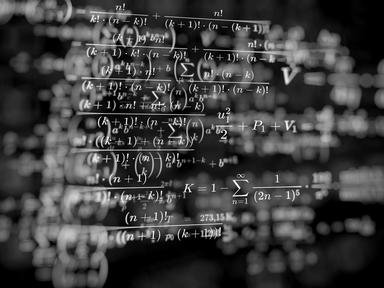Quiz Answer Key and Fun Facts
1. Arithmetic:
What is the remainder when 25 is divided by 8?
2. Basic Algebra:
Which of the following is the correct way to factor x^2 - 100?
3. Geometry:
A triangle has one side of length 8 and another side of length 10. Which of the following COULD NOT be the length of the third side?
4. Analytic Geometry:
Which of the following conics have asymptotes?
5. Calculus:
Suppose F(x) and G(x) are antiderivatives of a continuous function f(x). What can you say about their difference F(x) - G(x) ?
6. Analytic Geometry With Vectors:
Let a and b be two non-zero vectors in R^3 and let c = a x b denote their cross product. Which of the following is equal to the dot product of a and c?
7. Basic Set Theory:
If A and B are sets, let A - B denote the set of all elements of A that are not in B. Which of the following is TRUE?
8. Logic:
Which of the following statements is logically equivalent to p AND q? [Note: in the answers, NOT means "negation"]
9. Linear Algebra:
Let A be a 2 by 2 matrix with real entries that has 3 as one of its eigenvalues, and let v be an eigenvector belonging to the eigenvalue 3. Which of the following must equal Av?
10. Combinatorics:
Let (n choose k) denote the number of k element subsets of an n element set (also called a binomial coefficient). Which of the following is equal to (9 choose 5) + (9 choose 6) ?
11. Elementary Number Theory:
Let x and y be integers and let S denote the sum of their squares. Which of the following could S NOT be congruent to mod 4? In other words, if we divided the sum of the squares of two integers by 4, which of the following could not be a remainder?
12. Real Analysis:
Let a_n denote the sequence 2 + (-1)^n. What is the lim inf (as n goes to infinity) of a_n?
13. Group Theory:
Which of the following groups is abelian?
14. Ring Theory:
Let R be a ring (non-commutative) and let x and y be elements of R which satisfy yx = 3xy. Which of the following is equal to (x + y)^2?
15. Basic Topology:
Let X and Y be topological spaces, let U be an open set of X, V an open set of Y, and let f be a continuous function that maps X into Y. Which of the following must be true?
Source: Author
rodney_indy
This quiz was reviewed by FunTrivia editor
crisw before going online.
Any errors found in FunTrivia content are routinely corrected through our feedback system.
